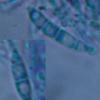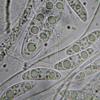
17-12-2025 18:35
 Michel Hairaud
Michel Hairaud
Bonjour à tous/Hi to everyone I am passing along

15-12-2025 15:48
 Danny Newman
Danny Newman
Melanospora cf. lagenaria on old, rotting, fallen

15-12-2025 15:54
 Johan Boonefaes
Johan Boonefaes
Unknown anamorph found on the ground in coastal sa

15-12-2025 21:11
 Hardware Tony
Hardware Tony
Small clavate hairs, negative croziers and IKI bb

15-12-2025 07:09
 Danny Newman
Danny Newman
indet. Rutstroemiaceae sp. on unk. fallen leavesMc

15-12-2025 07:05
 Danny Newman
Danny Newman
Pseudosclerococcum golindoi (det: Zotto)near Cosb

15-12-2025 11:49
 Danny Newman
Danny Newman
ITS sequences from the following two collections B

15-12-2025 12:34
 Danny Newman
Danny Newman
indet. Rhytismataceae on oak leafnear Purchase Roa
Ascocoryne.
Luc Bailly,
27-10-2009 16:31
Luc Bailly,
27-10-2009 16:35
Re:Ascocoryne.
... et parfois, j'ai des spores 1-septées comme chez A. sarcoides (il y a une paraphyse qui passe devant la spore). En outre, les dimensions sont intermédiaires.
Dois-je tout de même conclure sur A. cylichnium? Des intermédiaires entre les deux espèces sont-ils connus?
Pour info, c'est sur hêtre, les fructifications sont très mûres, et les prélèvements pour la micro viennent de la même partie d'une même fructification.
Votre avis?
Amitiés - Luc BAILLY.
Dois-je tout de même conclure sur A. cylichnium? Des intermédiaires entre les deux espèces sont-ils connus?
Pour info, c'est sur hêtre, les fructifications sont très mûres, et les prélèvements pour la micro viennent de la même partie d'une même fructification.
Votre avis?
Amitiés - Luc BAILLY.
Hans-Otto Baral,
27-10-2009 17:22

Re:Ascocoryne.
Without vital spores this question is hardly to answer. The confusion in Ascocoryne is simply the result of the fact that the literature has consequently been performed on dead material.
There do not exist any forms intermediate between A. sarcoides and A. cylichnium, instead the two species are very very distinct. But the still not validly described A. inflata is a close relative and could be the one you have. It is named for its strongly capitate paraphyses, did you look for them?
On the DVD I have a key on Ascocoryne which shows the relevant characters.
The septa can also be seen in water mounts when the spores are still alive. Then you can see the important oil drops. And by the way, Ascocoryne ejects spores always aseptate, septate spores are the result of a postmaturation process. A. cylichnium often has 5-6 septa while sarcoides and inflata max. 3 septa.
Zotto
There do not exist any forms intermediate between A. sarcoides and A. cylichnium, instead the two species are very very distinct. But the still not validly described A. inflata is a close relative and could be the one you have. It is named for its strongly capitate paraphyses, did you look for them?
On the DVD I have a key on Ascocoryne which shows the relevant characters.
The septa can also be seen in water mounts when the spores are still alive. Then you can see the important oil drops. And by the way, Ascocoryne ejects spores always aseptate, septate spores are the result of a postmaturation process. A. cylichnium often has 5-6 septa while sarcoides and inflata max. 3 septa.
Zotto
Luc Bailly,
27-10-2009 17:37
Hans-Otto Baral,
27-10-2009 17:40

Re:Ascocoryne.
That looks good! So cylichnium is completely excluded because of the two big oil drops (cylichnium is always multiguttulate).
A. inflata has rather small apothecia and is almost sessile, A. sarcoides usually much larger.
Zotto
A. inflata has rather small apothecia and is almost sessile, A. sarcoides usually much larger.
Zotto
Luc Bailly,
27-10-2009 18:13
Re:Ascocoryne.
So it's A. sarcoides. The apothecia's were quite large. Thanks, Zotto.



